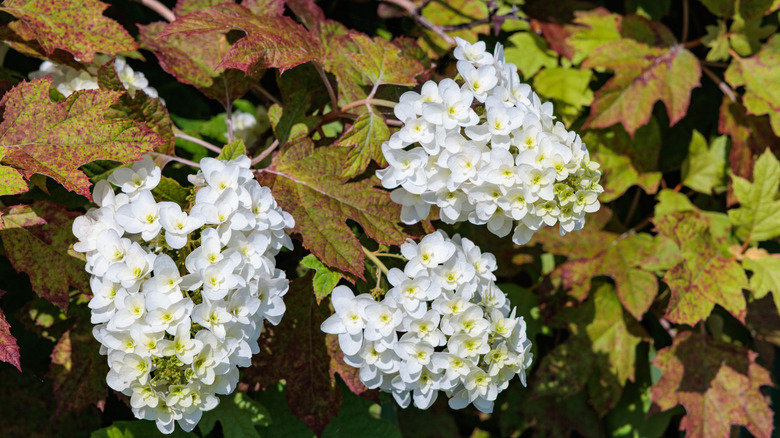The Hydrangea Variety You Should Plant For Gorgeous Color In The Fall
If you're not ready to let go of hydrangea season, you should be aware of this variety. The oak leaf hydrangea (Hydrangea quercifolia) is the perfect ornamental plant for fall. It blooms with pink, white, blue, or purple flowers from spring to summer. Timing may vary depending on your climate, but the blooms can last up to 12 weeks., so it often retains its flowers into fall. After the flowers die off, the oak leaf hydrangea's leaves will continue to decorate your garden in gorgeous shades of red, purple, orange, and burgundy.
Perennial in USDA zones 5 to 9, the oak leaf hydrangea is native to the warm, moist woods and ravines of the southeastern United States. In ideal conditions, hydrangeas are low-maintenance plants that hardly need any attention to thrive. Like most other hydrangea varieties, this variety grows to about 6 to 8 feet tall. It's well-suited to borders and hedges. While they offer a nectar-rich flower that supports birds and pollinators, oak leaf hydrangeas may not be suitable for households with pets. All parts of the oak leaf hydrangea are mildly toxic, and if large quantities are ingested, they can cause gastrointestinal issues.
Plant oak leaf hydrangeas for stunning fall colors
Plant your oak leaf hydrangeas where they can receive full sun to partial shade in organically rich, well-draining soil. Oak leaf hydrangeas prefer moderately moist soil, and mulching in the summer can help retain that moisture. Oakleaf hydrangeas prefer neutral to acidic soil, and may develop chlorosis in alkaline soil. For some varieties, you can change the color of your hydrangeas by altering the soil's pH, but oakleaf hydrangeas tend to display more consistent hues.
These shrubs require little pruning, but if you think your plant needs a trim, prune immediately after flowering. Oakleaf hydrangeas will form buds for next year's flowers on the old wood, so you'll want to avoid pruning too late. Winter-damaged stems can be pruned off in the early spring.
While they add lots of interest in fall, harsh cold can be a challenge for these plants. Oak leaf hydrangeas, especially those that are not yet established, benefit from a sheltered location and winter protection in cold climates, as frigid conditions can cause a significant loss of flower buds. Covering the ground at the base of the plant with mulch or burlap will provide insulation.

